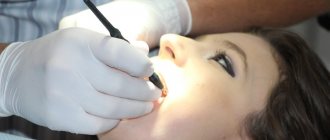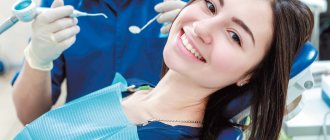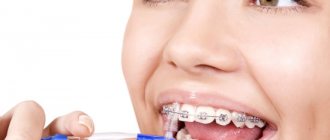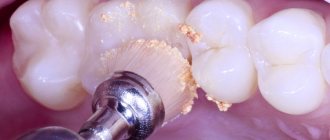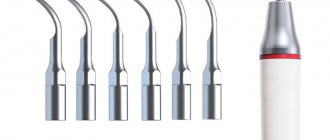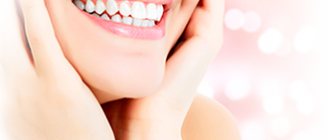You've probably come across the name of a dental service such as professional oral hygiene in an advertisement or on the Internet. And many people reasonably ask: why do you need to do oral hygiene at the dentist, if you can brush your teeth at home with a brush and toothpaste, use rinses and balms that are sold in the store?
The reason is quite simple: even regular and properly brushed teeth at home does not help to completely cleanse the oral cavity of soft plaque; it continues to accumulate and various pathogenic microorganisms actively multiply in it.
Their activities are fraught with the development of caries and inflammation of soft tissues. In addition, plaque can change the color of tooth enamel and teeth look unsightly.
professional oral hygiene procedure in dentistry helps to effectively remove plaque from dental surfaces and from all hard-to-reach places and thereby carry out effective prevention of almost all dental diseases
of dental oral hygiene include what methods are used to carry out the procedure? So that you can have answers to all these questions, we have prepared detailed material on the topic of professional dental and oral hygiene.
What is comprehensive teeth cleaning
Each of us follows basic hygiene rules, including brushing our teeth twice a day. With the help of this simple manipulation, we remove plaque accumulated during the day or night. But the problem is that the interdental spaces and hard-to-reach areas remain uncleaned or not cleaned well enough. As a result, plaque begins to accumulate in these places, and then mineralizes, that is, turns into tartar. It is impossible to remove it with a simple brush and paste. In this case, only professional help from a dentist will help.
The doctor, depending on the type of deposits, may suggest one or another method of cleansing.
The specificity of the instruments used determines the narrow focus of the impact. For example, ultrasonic waves can crush stone, and Air Flow technology can remove soft plaque. Human teeth simultaneously contain both already fossilized and still soft fractions, so for total cleansing it is necessary to use not just one method of professional hygiene, but several procedures in combination. In addition, the enamel layer, having lost its “shell” and has already begun to demineralize underneath, becomes very vulnerable for some time. Therefore, to restore it, it needs recharge, in particular fluorine. Based on the above, we can conclude that only a set of cleaning and protective measures will help your teeth be healthy and beautiful. Comprehensive cleaning includes the following procedures:
- ultrasonic treatment;
- cleansing using Air Flow technology;
- polishing the enamel layer;
- fluoridation.
Cleaning methods at the dentist
Professional hygienists and periodontists use a whole arsenal of methods for cleaning teeth. This can be the simplest influence (instrumental) or more advanced (Air Flo, ultrasonic, etc.). Which option to choose depends on the following factors:
- the patient’s health status, his well-being;
- thickness, structure, density of plaque or stone;
- age (some activities are contraindicated for children);
- location of formations;
- financial opportunities.
It is also possible to use several techniques for complex effects. In this way, you can speed up the onset of a positive result and prolong the effect for up to six months or more.
Mechanical (manual)
One of the oldest methods, which does not lose popularity due to its affordable price. The use of expensive equipment is not required here; the doctor uses special tools with hooks to remove hard deposits.
The procedure has a significant drawback. As a result of mechanical impact, the enamel may be damaged. It cannot be performed if a person has hypersensitivity. In some situations, this option is the only acceptable option if there are contraindications.
Using the Air Flow system
What is included in professional teeth cleaning with Air Flo: the teeth are treated with a mixture of water, abrasive particles and air. All this is supplied under a certain pressure. The layer is easily removed without causing any discomfort to the patient, and the structure of the units is not affected. The enamel becomes several shades lighter. Unfortunately, such a delicate method cannot get rid of old deposits.
Ultrasonic
Ultrasound crushes the hardened layers, and their particles are then washed out with water. This way you can remove plaque and stone not only from visible surfaces, but also from hard-to-reach places (for example, in the spaces between teeth). If the accumulated layer was too hard and old, discomfort may be present for several days.
Laser
The laser beam removes old deposits. The person does not experience pain or other discomfort; the incisors, canines and molars remain intact. The condition of soft tissues improves. In addition, the method helps disinfect the oral cavity. The procedure will cost more than other types of cleansing.
Polishing
In this way, the dentist eliminates unevenness and microcracks on surfaces that formed after applying the above methods. If you skip this step, the enamel will be rough and food particles will be trapped on it. As a result, plaque will very quickly accumulate again, harden and turn into stone.
How is hygienic teeth cleaning done, are special tools needed? Hard fabrics are polished using special devices alternating different types of attachments, such as:
- needle-shaped (for grinding);
- brushes (clean out leftover food);
- polishers (process crowns and dentures);
- discs (give perfect smoothness and shine);
- strips (for interdental spaces).
Fluoridation
This is an optional procedure, but it is still worth agreeing to it. It helps overcome sensitivity, strengthen enamel, and prevent the appearance of carious lesions. Surfaces are treated with special substances – fluorides.
Pros:
- the level of fluoride in the body is normalized;
- the strength of dental units increases;
- the leaching of calcium, which affects vital processes in the skeletal system, is stopped;
- the growth and reproduction of pathogenic microorganisms slows down.
What does the doctor do:
- drying is performed with a jet of air;
- a solution enriched with active ingredients is applied with a brush or using trays;
- recommendations for prevention are given.
Fluoridation is the final stage of purification in a clinical setting.
When is a procedural complex necessary and when it cannot be performed?
Indications for comprehensive cleaning:
- Prevention of caries and periodontal diseases
- Strengthening the enamel layer
- Improving smile aesthetics
- Removing tartar and soft deposits
- Eliminating bad breath
- Before dentures, implantation, installation of braces
- While wearing braces and after removing them
- For crowded teeth
Contraindications:
- Childhood
- Severe cardiovascular diseases
- Presence of a pacemaker
- Difficulty in nasal breathing
- Any disease in the acute period
- Allergy to components of medications used
Indications and contraindications for professional oral hygiene in dentistry
Like any other medical procedure, dental and oral hygiene has its own indications and contraindications. Indications include:
- The presence of soft or hard plaque on the dental surfaces;
- Inflammatory process affecting the gums;
- Presence of tartar;
- Prevention of the development of caries and other dental diseases;
- Enamel pigmentation as a result of smoking, frequent consumption of tea and coffee.
USEFUL TO KNOW: The dental hygiene procedure also helps to brighten them. After all the activities, the teeth brighten by about one to two shades. This is already a good result, but if you need perfect whiteness, then it is better to use an additional service of modern dentistry after hygiene - professional whitening!
Professional dental and oral hygiene must be performed before prosthetics, implantation, orthodontic treatment using braces, installation of veneers and lumineers.
Also, the professional hygiene procedure can be part of complex therapy in the treatment of diseases such as periodontitis and periodontal disease. It is also recommended for expectant mothers to undergo professional cleaning of their teeth and oral cavity in dentistry: during pregnancy, the risks of caries increase significantly and high-quality oral hygiene will be an excellent prevention of this disease!
However, in some cases it is impossible to maintain oral and dental hygiene. For example, with stomatitis, general infectious diseases of the body in acute form. First, it will be necessary to eliminate these diseases and only then will it be possible to undergo the procedure.
Professional oral hygiene is not recommended in case of severe thinning of the enamel or erosion of the enamel coating of the teeth. Under such circumstances, the procedure can do more harm than good!
Indications and contraindications for professional dental and oral hygiene are determined at a dental appointment: the doctor will conduct an examination and tell you whether in your case it is possible to undergo the procedure immediately or whether preliminary measures will be needed that will improve the quality of hygiene and make it as safe as possible for you!
The first stage is ultrasonic treatment
Ultrasound of a certain frequency is capable of coloring tartar into small fragments. Therefore, it is used to remove mineralized deposits on the enamel layer in the supragingival and subgingival zone. This procedure is the first item on a comprehensive list. An ultrasonic scaler destroys stone and, along with it, removes pathogenic microflora in the most inaccessible places of the dentition. Ultrasound is absolutely safe for human health in general and gums in particular. The scaler has an attachment that focuses ultrasound radiation on the area that needs to be treated. The device allows manual adjustment of the intensity of exposure. It is determined by the dentist depending on the conditions of a particular clinical case.
Important: a bonus of using ultrasound is its ability to destroy pathogenic bacteria, i.e., to disinfect the surface being treated. Therefore, dentists strongly recommend performing this procedure for patients with periodontal health problems, not only during a course of treatment, but also regularly to prevent inflammation.
Second stage – Air Flow
After removing hard contaminants, it is time for deposits with a soft structure. Cleansing is performed using Air Flow technology. Using a special apparatus, a mixture of water, air and tiny grains of soda is applied to the surface of the patient’s teeth. The abrasive size is so small that it can destroy the bacterial film, but cannot leave scratches on the enamel surface. A stream of abrasive mixture directed under pressure destroys pigmented plaque and immediately washes it away. Thanks to this, the enamel is lightened to its natural tone (by about 1 - 2 shades on the Vita scale).
Note: the process is painless, but may cause slight discomfort for people with hypersensitive enamel. In this case, the doctor may suggest local anesthesia. Patients who are allergic to soda should not perform this cleaning.
How to brush your teeth correctly
To ensure proper oral hygiene, it is not enough to choose the right toothbrush, toothpaste and other products. Proper cleaning technique must be followed to completely remove plaque and tartar from the enamel surface. The basic rules of this procedure are as follows:
- making rotational movements, trying to remove food debris from the interdental space, move it from the gum to the tooth;
- Using gentle back-and-forth movements, clean the entire tooth: outer, inner and chewing surfaces. The procedure should take about 3 minutes;
- clean the surface of your tongue to freshen your breath and rid your mouth of bacteria as much as possible;
- use dental floss;
- Rinse your mouth with mouthwash for 30 seconds.
Dentists distinguish several methods of brushing teeth. The appropriate one is determined individually; it is better to consult a dentist about this. What all methods have in common is that they are performed for at least three minutes and at the same pace.
On average, instead of the allotted three minutes, people spend 46 seconds brushing their teeth.
Universal cleaning suits everyone. With it, two teeth are cleaned in turn in the direction from the gums to the cutting part of the tooth. The outer side of the teeth is cleaned first, and only then the inner side. If there are no gum diseases, you can complement the procedure with a massage using circular movements of the gums.
During standard brushing, the brush should be held at a 45-degree angle to the gum.
Brushing harshly will help remove plaque effectively, but is not suitable for people with painful gums. The brush is positioned perpendicular to the buccal surface and moves in a circle from the internal surfaces to the chewing surfaces.
Gentle brushing will not harm sensitive gums. Vertical movements from the gums down are made with the teeth closed when cleaning the front surface and with the jaw open when cleaning the inner surface.
The technique of using dental floss also implies several rules. First, the floss should be about 45 cm long. For each brushing, use a new section 3-5 cm long. The interdental spaces should be cleaned with gentle movements, following the contours of the gums. Go to the surface of the teeth below the gum line, but do it carefully, avoiding sudden movements.
Third stage - polishing
Deposits leave microcracks and irregularities on the enamel layer. Therefore, polishing is necessary after cleaning procedures. Otherwise, the remaining roughness will become a “magnet” for microparticles of food, which will very quickly turn into new deposits. Polishing is performed using abrasive pastes and various attachments driven by a drill. These are polishers, brushes, discs, needle-shaped attachments. The interdental areas are polished with special strips. The process does not cause pain and takes about 40 minutes.
Possible contraindications
Despite the safety of hygienic cleaning, this procedure is contraindicated for some patients. It is not recommended if you have:
- arrhythmias;
- increased sensitivity or erosion of enamel;
- gingivitis;
- acute respiratory diseases.
Dental hygienic treatment is prohibited for pregnant women and adolescents who have not changed their primary dentition to a permanent one. If there are contraindications, the doctor can carry out the procedure manually or using special pastes and attachments for a drill. This will allow you to simultaneously remove deposits and polish the enamel.
The fourth stage - fluoridation
As a rule, fluoridation is not included in the calculation of comprehensive professional hygiene, but it is very important for dental health. The application of fluoride helps strengthen the enamel layer (prevents the leaching of calcium), reduces hypersensitivity, prevents the onset of caries (slows down the proliferation of pathogenic bacteria). Therefore, you should not refuse this procedure. Fluoridation algorithm: the doctor dries the surface to be treated with a warm air stream, then applies fluoride varnish (a harmless composition based on varnish with a high concentration of fluorides) to each element of the dentition, then dries it.
Note: after completing all stages of comprehensive cleansing, teeth become noticeably lighter, reaching their natural natural color. But those patients who dream of a snow-white smile can resort to whitening, for example, using the ZOOM-4 method.
Abrasiveness of toothpaste
Abrasiveness is considered an indicator of the ability of toothpaste to disrupt the structure of enamel and dentin due to abrasion.
The abrasive substances in the paste are responsible for this indicator: silicon compounds, silicon dioxide, hydrated silicon dioxide, or calcium carbonate and calcium phosphate compounds.
A high degree of abrasiveness, although it contributes to high cleaning power, but at the same time causes more damage to tooth enamel. There are 4 levels of toothpaste abrasiveness:
- Low level of abrasiveness - RDA 0-70. Recommended for children and adolescents up to 12-14 years old and adults with hypersensitivity of teeth and gums. For children under 6-7 years of age, an abrasiveness of up to 40 is more suitable. Such pastes have minimal impact on tooth enamel and dentin.
- The average level of abrasiveness is RDA 70-100. This level of abrasiveness is suitable for children from 14 years of age for daily brushing of teeth. Such pastes help maintain the natural color of teeth after professional cleaning and whitening. If you have increased sensitivity of your teeth and gums, it is better to use pastes with low abrasiveness.
- High level of abrasiveness - RDA 100-150. Recommended for people over 14 years old. If you often drink tea, coffee drinks, or tobacco, then periodic use of highly abrasive paste is also suitable for you. When used occasionally and alternating with a paste of medium abrasiveness, it cleans well and does not seriously injure the enamel.
- Very high level of abrasiveness - RDA above 150. Dentists do not recommend using such pastes frequently, as they can cause serious damage to the enamel. Only a specialist can prescribe high abrasive pastes. You must brush your teeth strictly following your doctor's recommendations.
Dentists' tips for caring for your teeth after a comprehensive cleaning
It is in the patient’s interests that the effect of the complex of procedures lasts as long as possible. Therefore, it is important to follow the following recommendations from your dentist in the first few days:
- do not eat or drink for 2 hours after visiting the dentist;
- You should brush your teeth for 3–5 minutes after each meal and at night;
- possible increase in enamel sensitivity. Do not consume food or drinks that are too hot or too cold;
- try not to smoke, tobacco tars eat into the enamel very quickly;
- Reduce (or eliminate) from your diet foods and drinks that contain high amounts of natural and artificial coloring substances.
The dental network offers comprehensive teeth cleaning services. Our clinic offers family and savings discounts. Doctors are highly qualified and improve their skills in leading dental clinics in Russia and Europe. The level of services provided meets international standards.
Branches of our orthodontic center are located in Moscow within walking distance from the metro:
- Art. Alekseevskaya (VDNKh district, etc. Mira), address: st. 3rd Mytishchiskaya house 3, building 2;
- Art. Shelepikha, address: Shelepikhinskaya embankment, address: building 34, building 1.
We will make your teeth strong, beautiful and healthy! Come and see for yourself.
Dental and oral hygiene in dentistry: why is it so important to undergo the procedure regularly?
The main task of oral hygiene is to remove hard and soft plaque from the surfaces of the teeth, as well as other areas and areas of the mouth.
Regular and timely removal of dental plaque will be the best prevention of caries and other dental diseases. In addition, oral hygiene in dentistry contributes to:
- Formation of healthy strong teeth;
- Complete destruction of harmful microorganisms that live in large numbers in the human oral cavity;
- Prevention of periodontal and gastrointestinal diseases.
Professional dental and oral hygiene helps keep your teeth enamel in excellent condition - after brushing, your teeth become whiter and your smile looks attractive! Professional oral hygiene is especially recommended for people with bad habits: smokers, patients who abuse strong tea and coffee. The procedure is also indicated for people with poor immunity, because often malfunctions in the body’s immune system are expressed precisely in the appearance of caries and inflammation in the oral cavity.
Regular dental hygiene will ultimately result in significant savings on dental treatment costs.
Which is inevitable if the teeth are not properly cared for and are covered with a thick layer of plaque. So, professional oral hygiene is certainly not a waste of time and money; on the contrary, it is a valuable investment in your own health!

